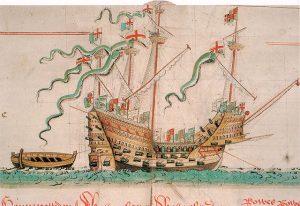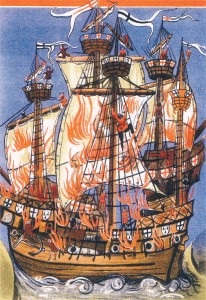
The Mary Rose
On this day in history, 10th August 1512, the Battle of Saint-Mathieu took place. It was a naval battle in the War of the League of Cambrai and it was between the English and Franco-Breton fleets off the coast of Brest, in present day Brittany, France. England was allied with Spain and the Holy Roman Empire at this time.
The Mary Rose, Henry VIII's famous warship whose wreck was discovered in 1971 and raised in 1982, was chosen as the English fleet's flagship by Sir Edward Howard, Admiral of the English fleet. It was her first battle. The twenty-five ship English fleet had set out from Portsmouth, on the south coast of England, after hearing news of the twenty-one ship French fleet gathering at Brest, and the two fleets engaged in Berthaume Bay on 10th August 1512.
The Mary Rose museum website states:
"It was the Mary Rose that, according to records, drew first blood, when she shot off the main mast of the French flagship Grand Louise, commanded by Admiral René de Clermont. Although the Grand Louise was able to escape, with the loss of 300 men, this marked the first time in the history of Naval warfare that ships with lidded gunports had engaged one another."
The English fleet was victorious but its largest ship, the Regent, sank, as did France's the Marie La Cordelière. The two ships had been firing at each other at close quarters when a fire broke out on board La Cordelière. It soon reached the ship's powder magazines and when that happened both the Regent and La Cordelière were blown up. Both captains were killed, along with around 1,500 men. Those killed included Sir Thomas Knyvet and Sir John Carew who had been given joint command of the Regent. Edward Hall recorded this in his chronicle:

Marie la Cordelière and the English Regent ablaze
Charles Wriothesley summed it up in one sentence:
"This yeare the Regent of England, a shippe, and a carike of France, were burnt in Bristowe haven, and Sir Thomas Knyvett in her with all his men."
Cardinal Thomas Wolsey wrote of the battle in a letter to Richard Fox, Bishop of Winchester:
"Gives an account of a severe sea fight near Brest on Tuesday fortnight, where the Regent captured the great carrick of Brest; but both, fouling, were burnt, and most part of the crew in them. Sir Thos. Knyvet and Sir John Carewe slain. Begs he will keep the news secret. Farnham, 26 Aug. Signed: "Thomas Wulcy."
P.S.—The French fleet has fled to Brest. Sir Edward [Howard] has vowed "that he will never see the King in the face till he hath revenged the death of the noble and valiant knight Sir Thomas Knyvet.""
Sources and Further Reading
- Hall, Edward (1809) Hall's chronicle: containing the history of England, during the reign of Henry the Fourth, and the succeeding monarchs, to the end of the reign of Henry the Eighth, in which are particularly described the manners and customs of those periods. Carefully collated with the editions of 1548 and 1550, London, Printed for J. Johnson, p. p. 534. Read online at http://www.archive.org/stream/hallschronicleco00halluoft#page/534/mode/2up
- Wriothesley, Charles (1875) A chronicle of England during the reigns of the Tudors, from A.D. 1485 to 1559, Volume 1, p. 7, read online at https://archive.org/details/chronicleengland00wriouoft
- "A Day in History, Tuesday 10th August 1512", Early Modern Forum 1450-1850, University of Warwick. http://www2.warwick.ac.uk/fac/arts/emforum/projects/adayinhistory/10august1512/
- Letters and Papers, Foreign and Domestic, Henry VIII, Volume 1: 1356.
- The first battle of the Mary Rose, Mary Rose Museum - http://www.maryrose.org/the-first-battle-of-the-mary-rose/



Hi. Just to correct that the Mary Rose was re-discovered NOT in 1971. Alex McKee first used sonar for archaeology purposes in 1966 and found a ‘W’ anomoly. By using their hands, divers dug 6-9 metres to find timbers. In 1967 Margaret Rule, leading archaeologist, joined the team and excavation began.The Mary Rose 1967 Committee was formed and in 1968 they leased the wreck site on the seabed to protect it 🙂
Thank you, Phil! I got it from the Mary Rose website – http://www.maryrose.org/: “The Mary Rose is a Tudor ship, built in 1510. In service for 34 years. Sank in 1545. Discovered in 1971. Raised in 1982. Now in the final stages of conservation, she takes her place in a stunning and unique museum.” I think they base the 1971 date on the port frames being discovered and actually being identified as the Mary Rose, not sure. They talk about the 5th May 1971 as being the climax of the investigation so perhaps why they’ve picked that date, I don’t know.
Do you want to write an article about the dives and rediscovery, by the way, Phil? It would make for an interesting read for members.
“France’s the Marie La Cordelière”
Hi,
Just to correct that the Marie la Cordelière was the flat ship of the Ducal Navy…
Brittany was still an independant european country at this time.
Even if the Duchess was married with the King of France, both countries remainded independant from each other.
So, in no way the Marie a Cordelière was a french ship
😉